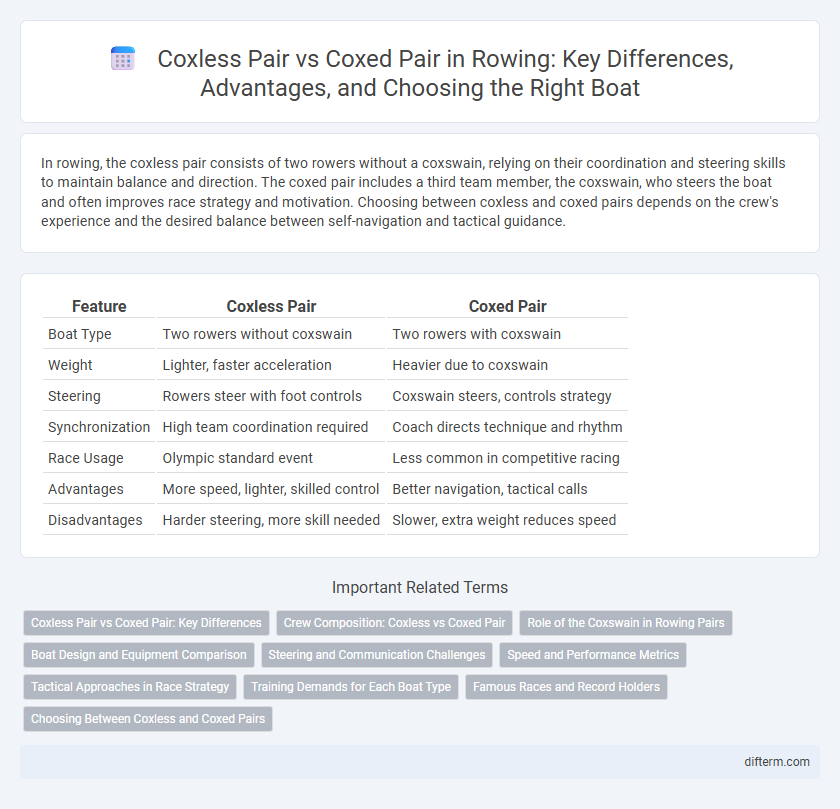In rowing, the coxless pair consists of two rowers without a coxswain, relying on their coordination and steering skills to maintain balance and direction. The coxed pair includes a third team member, the coxswain, who steers the boat and often improves race strategy and motivation. Choosing between coxless and coxed pairs depends on the crew's experience and the desired balance between self-navigation and tactical guidance.
Table of Comparison
| Feature | Coxless Pair | Coxed Pair |
|---|---|---|
| Boat Type | Two rowers without coxswain | Two rowers with coxswain |
| Weight | Lighter, faster acceleration | Heavier due to coxswain |
| Steering | Rowers steer with foot controls | Coxswain steers, controls strategy |
| Synchronization | High team coordination required | Coach directs technique and rhythm |
| Race Usage | Olympic standard event | Less common in competitive racing |
| Advantages | More speed, lighter, skilled control | Better navigation, tactical calls |
| Disadvantages | Harder steering, more skill needed | Slower, extra weight reduces speed |
Coxless Pair vs Coxed Pair: Key Differences
Coxless pair rowing involves two rowers without a coxswain, requiring both athletes to coordinate steering and stroke rate, enhancing synchronization and teamwork. In contrast, coxed pair rowing includes a coxswain who steers and directs the crew, allowing rowers to focus solely on power and technique. The absence of a coxswain in coxless pairs typically results in a lighter boat and faster speeds but demands higher skill in navigation and balance.
Crew Composition: Coxless vs Coxed Pair
A coxless pair in rowing consists of two rowers without a coxswain, requiring both athletes to coordinate steering and power delivery through precise communication and technique. In contrast, a coxed pair includes a third crew member, the coxswain, who steers the boat and directs race strategy, allowing the rowers to focus solely on power and rhythm. The absence of a coxswain in coxless pairs demands higher skill in boat balance and navigation, while coxed pairs benefit from tactical guidance and improved steering efficiency.
Role of the Coxswain in Rowing Pairs
In rowing pairs, the coxswain plays a crucial role in navigation, strategy, and motivation during a race, ensuring optimal boat balance and course accuracy in coxed pairs. Coxless pairs rely entirely on rowers for steering and coordination, increasing the physical and technical demands on the athletes. The presence of a coxswain allows rowers to focus solely on power and rhythm, enhancing team synchronization and race tactics.
Boat Design and Equipment Comparison
Coxless pair rowing shells are lighter and more streamlined than coxed pairs due to the absence of a coxswain's seat and steering equipment, enhancing speed and responsiveness. Coxed pairs include an additional seat for the coxswain and steering mechanisms like a rudder, increasing weight but improving navigation and coordination during races. Both boat types use carbon fiber composites for hull construction and similar rigging setups, but the coxless pair demands greater synchronization between rowers for effective steering and balance.
Steering and Communication Challenges
Coxless pairs require rowers to manage steering through subtle pressure differences on their oars, demanding heightened synchronization and spatial awareness. In contrast, coxed pairs rely on the coxswain for precise navigation and race strategy communication, allowing rowers to focus primarily on power and rhythm. The absence of a coxswain in coxless pairs increases communication challenges between rowers, necessitating non-verbal cues and an acute sense of coordination to maintain optimal course and speed.
Speed and Performance Metrics
Coxless pairs typically achieve faster race times than coxed pairs due to the absence of the extra weight of the coxswain, improving boat speed and acceleration. Performance metrics such as stroke rate and synchronization are often higher in coxless pairs because rowers must maintain balance and steering without external guidance. Data from international regattas show coxless pairs consistently outperform coxed pairs in standard 2000-meter events, emphasizing their efficiency in competitive rowing.
Tactical Approaches in Race Strategy
In coxless pair rowing, tactical approaches rely heavily on seamless coordination and real-time communication between the two rowers to maintain optimal boat balance and stroke synchronization. Coxed pairs benefit from the coxswain's ability to implement strategic race calls, adjust pacing, and steer effectively, allowing rowers to concentrate solely on power and technique. Race strategies in coxed pairs often emphasize precise navigation through tight courses, while coxless pairs prioritize adaptive rhythm control and in-the-moment decision-making to respond to competitors' moves.
Training Demands for Each Boat Type
Training for coxless pairs emphasizes synchronization and balance between the two rowers, requiring heightened communication and technical skill to maintain stability without a coxswain's guidance. In contrast, coxed pair training allows rowers to focus more on power output and endurance, as the coxswain handles steering and race strategy. Both boat types demand rigorous cardiovascular conditioning, but coxless pairs place a greater emphasis on teamwork and mental focus to manage navigation and rhythm.
Famous Races and Record Holders
The coxless pair demands exceptional synchronicity between two rowers without a coxswain, showcased in famous races such as the Olympic finals featuring Sir Steve Redgrave and Matthew Pinsent, who hold multiple gold medals in this category. In contrast, the coxed pair incorporates a coxswain for steering, with record holders like the Italian team of Giuseppe Moioli, whose 1948 Olympic victory remains iconic. These disciplines highlight distinct strategic dynamics and have produced legendary performances in international rowing competitions.
Choosing Between Coxless and Coxed Pairs
Choosing between coxless and coxed pairs in rowing hinges on the crew's skill level and race strategy; coxless pairs demand greater coordination and technical precision from rowers since there is no coxswain to steer or provide commands. Coxed pairs offer strategic advantages in steering and race management, allowing rowers to focus solely on power and rhythm, which can be crucial in longer or tactical races. Competitive teams often prefer coxless pairs for speed and efficiency, while coxed pairs are favored in novice or training contexts to enhance communication and navigation.
coxless pair vs coxed pair (rowing) Infographic

 difterm.com
difterm.com